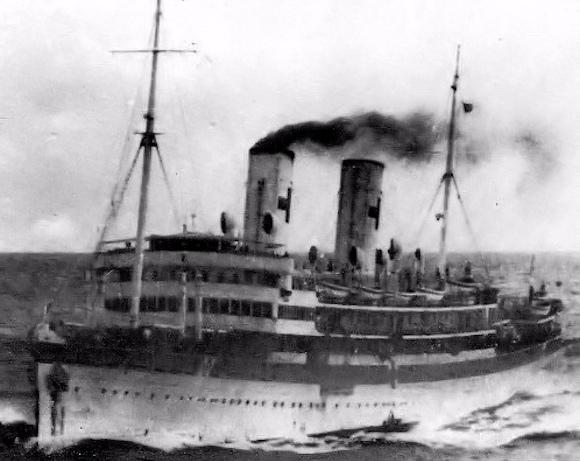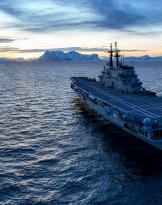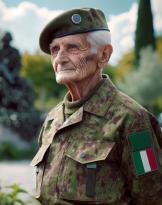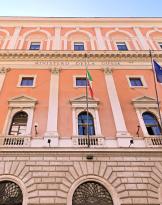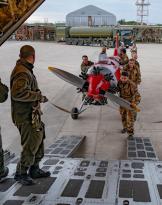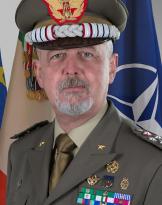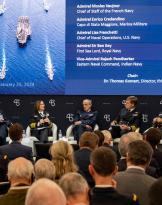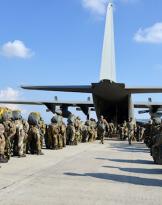Tsushima by Frank Thiess, from Book Four - The Battle: ... The morning rises and from the mist of dawn, a ship rises. It is the ship of the line Sisoj Velikij! The signals are exchanged, but she too is already fatally wounded, she is no longer in a position to take on board the crew of the Vladimir Monomàch. The Sisoj Velikij disappears again and a young and fresh unit appears in its place: the Japanese auxiliary cruiser Sado Maru. Quick and skilful maneuver and shoot against the Monomàch; but it is at the end of its strength. Commander Popov orders the machines to be stopped, the Kingstons to be opened, the boats to be put out to sea, and it's all over. The cruiser slowly sinks before everyone's eyes.
It is a wonderful hour! The disc of the sun rises above the clouds of dawn, color of chrome and purple, and slightly reddens the moving water that looks like blood from the dying ship. The Japanese see how it begins to dive with the bow, they see the waves rising on deck, they first see the funnels from which a little more smoke comes out, then only the trees protrude from the inexorable waves, and one of them is taken by sudden emotion, intones an ancient war song: "With sword in hand". Others join, and eventually the entire crew of the cruiser Sado Maru sings the hymn of the dying warrior in chorus; he sings it while his cannons are silent, above the marine tomb of the Monomàch, until it disappears and also the last tree top with the half torn flag waving. And the Russian sailors, who are in the water and those who have been rescued from the boats, shout the last hurray to their old cruiser. The old man thus had an honorable burial ... (pages 372 and 373)
A story of other times, a Greek tragedy full of pathos, described by a Thiess, a giant of literature.
5.045 Russian sailors died, more than 800 were wounded or bruised and recovered, which together with other 6.106 survivors taken on the surrendered ships and smoking on the hostile sea, all fell prisoners of the Japanese, who also captured the two hospital ships in the wake of the Russian fleet in Tsushima. In navigation with "via" lights and onboard lights on, in compliance with international conventions, it was these hospital ships that brought relief and life, and despite the contrary orders of the adm. Rosevenztkij, to reveal to the Fleet of the adm. Togo, the position of the Russian one and also decree its end.
Two hospital ships, including the Oryol which measured 6000 tons. that already from the start, at the beginning of their very long mission, were inadequate in number and size, to satisfy the health need that followed in a systematic way already with the only duration of the journey and also cruel after a bloody battle like that of Tsushima, both from a preventive and curative point of view.
Proof of the need for health, is the further testimony that the masterpiece of Thiess handed down to us: (page 376 - The Japanese - ed) They went away but did not forget the shipwrecked enemies and sent the America Maru to the place of the sinking. The auxiliary cruiser runs there, and a few hours later finds 291 survivors there. The men are half dead, several mad, many wounded, twenty-three of them seriously. They are brought on board: look, they move their arms, their hands, as if they were still men, but they are no longer men. ... Then one begins to tell, and tells how many there were and how one after the other, very slowly, they all drowned: between shouts, laughter, prayers, songs, biting around, or helping each other until death. The saviors turn away. They are old seamen, but they had never seen such things before. Here came hell out of its depths, and with its tongues of fire it swallowed wretched beings into its jaws, who had once been fathers and brothers who had once been men like them. And so from ship to ship.
And in Italy?
It is really true that we are often second to none. Unfortunately then ...
Something had moved in the heroic years of the second half of the 1800s, all permeated by the spirit of the Risorgimento, Dr. Cesare Castiglioni set up the "Milanese Committee of the Italian Medical Association for Aid to the Sick and Wounded in War" and became its president on June 15, 1864. The committee had the intention of acting in accordance with the numerous national associations formed at that time with the same purposes, in Europe that were born thanks to the work of Henry Dunant, who was shocked by horror, previously joined, during the battle of Solferino in 1859, the many Italian civilians of the place who gave assistance as they could to the wounded of every part. The International Red Cross was born.
In Italy, the first hospital ship, the "Washington", was also set up in 1866, even if the inspector Luigi Verde at the head of the Regia Marina medical corps, which took care of it, lost his life the same year, during the battle of Lissa.
However, the modern concept of hospital ship providing aid, officially safeguarded by rules and recognized by special international institutions, was established only with the Hague Convention of 1907. But it was still not enough to satisfy the needs for first aid, care and safety. .
Over the years, the need to prevent and contain the loss of human life at sea, not only after a naval confrontation, therefore as a consequence of a war, in 1912, was crudely highlighted in the eyes of international public opinion and governments, by the tragedy of the RMS Titanic, which despite the use of Marconi telegraphy, suffered a great loss of human life.
So in 1914, the first convention for the safeguarding of human life at sea was approved in London, aimed at regulating every aspect of life on board ships that could involve a risk of human life, not only for passengers but also for crews. Things could start to change ...
In Italy, during the First World War - and more in the Second World War as the operational chessboard changed and expanded - the Regia Marina prevented the risk of loss of human life on the sea, setting up 22 ships of different tonnage, employing personnel and resources to disposing of doctors, nurses, red cross nurses, operating theaters, wards for the sick, injured and shipwrecked, isolation, disinfection and disinfestation wards. They operated in theaters of war often in sight of the enemy, between difficulties of all kinds, and a common denominator based on bombings, mines, torpedoes and even cannon shots deliberately aimed at them.
We thus had: Gradisca, Po (Photo) Aquileia, Arno, California, Virgilio, Tiber, Toscana, Sicilia, Princess Joan, City of Trapani, Laurana, Orlando, Sorrento, San Giusto, Epomeo, Meta e Capri, and the largest Vulcania, Saturnia, Julius Caesar e Duilio; their livery, according to the conventions, was immaculate white, with the red Cross painted on the funnels and on the sides, on the latter, also together with the tricolor flag.
For the record, after the battle of Cape Matapan between the Royal Navy and the Regia Marina which ended on the night between 28 and 29 March, in addition to the English and Greek rescuers who immediately recovered about 1.300 sailors, the ship "Gradisca" also arrived in those waters. antiquated and with little speed, in need of work for a use at that time, which is not called frenetic, given the continuous help it had to bring. He arrived in the sea of Cape Matapan, during the day of April 30, 1941, and in a sort of impossible mission, he stayed in that sea for several days, to search for and save what remained on miles and miles of water, of scattered men, shipwrecked , injured, stressed, dehydrated and starved, in hypothermic conditions and so on, and of whom you had no idea how many there were. However, the ship "Gradisca" did its sad job, because it snatched 161 survivors of the massacre from the sea, all in poor psychophysical conditions.
The hospital ship "Po", which unlike the Russian "Orjol", traveled with the lights off in obedience to the orders received and despite having to have the lights on the board turned on according to international regulations, it was slammed without escape on the bottom of the bay of Valona at at 23 pm and 15 pm on March 14, 1941, by a torpedo released by an English torpedo bomber which hit the steamship on the right side. It was the umpteenth ship of those mentioned above, which left violently, at the hands of the enemy. Twenty-two people died including sailors and Red Cross workers.
In 1941, when the fate of the war began to take shape with the occupation of East Africa by the British, they made themselves available to repatriate our compatriots residing in the former colonies, such as: women, old children and disabled people. A huge rescue mission was then organized, with full success by Italy, in favor of Italian civilians residing in the former colony of the Horn of Africa, sending the transatlantic Julius Caesar e Duilio twins, and the couple Saturnia e Vulcania; quickly with great difficulty, being at war, the four were all set up as hospital ships with the best of existing technology and logistics, and leaving ample space on the edge for civilian life. From 4 April 1942, the White fleet began a first voyage from Genoa, with a route through Gibraltar, via the Cape of Good Hope, the Indian Ocean, to the Horn of Africa, for thousands and thousands of miles.
Until 1943, four o'clock White Ships they made 3 trips, bringing back 30.000 (thirty thousand) people to their homeland, carrying out a titanic undertaking permeated with extremely high risks and a thousand pitfalls of enemies, who nevertheless, for the entire duration of the repatriation operation, kept constant collaborative spirit and word given to the Italians until the end; threats also came from "friends", as the German dictator threatened the Italians to get his own to resolve Submarine, what was a problem for him was their communication with the British, with submarine attacks. Unfortunately, a little later, he succeeded with the RN Roma, RIP.
It was thus evident that with the White Fleet, it was not a question of moving prisoners of war or troops from one ocean to another, as is typical of a world conflict, but of a recovery from one ocean to another of civilians, of thousands of people without the most active and protective of their families, nuclei therefore in need of the best attention to their people and because at the mercy of a world, which at that moment rejected them, and had become hostile and dangerous for them.
When it was all over, at the end of the conflict, twenty-two White ships, only two were saved: the great transatlantic liners Saturnia e Vulcania. At least those. Here one wonders, thank goodness they were hospital ships, otherwise between enemy fire and "friend", only the Lord knows what would have happened to them.
The postwar period followed, with the rebirth of our country, but the restrictions of the peace treaties, the just and understandable desire to return to live of the people and the dust of history, covered the teachings of the extraordinary, unparalleled experience made by the Navy with the recovery operation of Italian refugees.
What remains today of the Hospital Ships, of their distant echoes, of those voyages to the limit of the impossible that involved the sacrifice of life, of Men and Women, whether they were of the Royal Navy, or of the Merchant Navy, or medical personnel, or Red Cross nurses, or religious personnel, military survivors and civilians, sick, shipwrecked all embarked on Ships drawn from the waters, often dead together and at the same time, and their sacrifice that has never been sufficiently remembered and repaid?
Will they ever be remembered, in some way by the younger generations? Moreover, how many people today feel the need for the state to have modern hospital ships today? Will it be enough to make this clear to the State, to Parliament, to the Government that we are dealing with COVID, earthquakes, the continuous rumblings of volcanoes, not to mention Marsili at the bottom of the Tyrrhenian Sea?
By the way, how many hospital ships does our Navy have in the roles today? None right?
It is never possible that the need for modern units is not perceived in public opinion and not only, no matter if they are more "white" than "gray", conceived, designed and built to obtain a wide versatility of use, in response and aid to the People, in case of humanitarian emergencies, natural disasters, earthquakes, environmental protection, etc. Ships used in synergy with SSN, SMOM, Civil Protection, Holy See, etc. and organized for the health aspect by Ministry specialists della Salute, Ministry of the Environment and Land and Sea Protection, which in addition to carrying out CBRN defense, and much more, etc., which all together could make a real strengthening of civil-military and international cooperation in addition to the considerable return in terms of visibility and prestige for Italy ?.
All this should not be difficult to implement, as regards how to do it, we have our own shipbuilding industry, perennially in need of receiving orders also to maintain the employment levels of well-trained workers; it is known that it bases its knowledge in the past centuries like very few others in the world, and can therefore build ships to meet urgent preventive, curative and rehabilitative needs in extreme emergency, including Covid. Is there 50% of the population affected positive for a virus in City X? I send one of the Ships to the nearest place, double in a fiat all the beds and then let's see what to do.
They could be built and set up with specific modules, for example: equipped as an operating room, for radiology, modules for laboratory analysis, pharmacies, modules with autonomous oxygen production systems, embarked or unloaded from time to time, with very short notice and according to of adversity to be contained or eliminated. Naturally, all modules should be standardized, made rigorously the same, to allow, if necessary, a rapid maintenance even one module at a time independently from other modules, including their disinfection and disinfestation, as well as obtaining a reasonable containment of both construction and management.
What about the money? There are not! Someone will immediately say ...
No! I say, the money can be found, whoever has a head and money, if the understanding is serious, understands it, and cuts them off; you need the will and believe in what you do, just propose a finished product, around the world and the orders will arrive, today there is too much need for security in world public opinion in general, and for the authorities civilians is an excellent and concrete way to guarantee it to their administrators.
Po ... I would call one ship "Po", the other ship "Gradisca", to remember All Sisters lost.
A prayer for All the Sailors who have never returned, whatever the Flag they served, especially a prayer addressed to Those who fell at Cape Matapan. RIP
Signature letter: Dimitri del Don
PS said Confucius: do not give fish but teach how to fish

